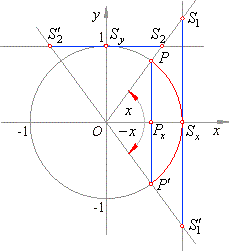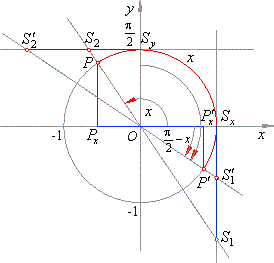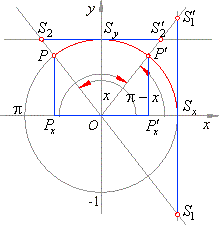|
| Trigonometry |
|
|
|
|
 Trigonometric
functions of arcs from 0
to ±
2p
Trigonometric
functions of arcs from 0
to ±
2p
|
 Trigonometric
functions of negative arcs or angles
Trigonometric
functions of negative arcs or angles |
 Trigonometric
functions of complementary angles
Trigonometric
functions of complementary angles |
 Trigonometric
functions of supplementary angles
Trigonometric
functions of supplementary angles |
|
|
|
|
|
|
|
|
Trigonometric
functions of arcs from 0
to ±
2p
|
|
Trigonometric
functions of negative arcs or angles
|
| We say that arcs x
and x′
are opposite if |
| x
+ x′
= 0 or x′
= -x.
|
| Comparing the corresponding sides of the congruent |
| right-angled triangles in
the right figure, |
| OPxP
and OPxP′ |
| OSxS1
and OSxS1′ |
| OSyS2
and OSyS2′ |
| follows that we can express trigonometric functions of an |
| negative arc
(-x) by corresponding function of opposite arc |
| x, that is |
|
 |
|

|
|
|
| Example:
Given trigonometric functions of negative angle, arc or number should be expressed by the
same functions of the positive angle, arc or
number.
|
|
a) sin
(-200°),
b) cos (-14p/3),
c) tan (-11),
d) cot (-750°).
|
| Solution: First express the angle
a
in decimal degrees, i.e. |
|
a) sin
(-200°)
= -
sin 200°
|

|
|
c) tan
(-11)
= -
tan11 = -
tan (3p
+ 1.575222...) = -
tan 1.575222...
|
|
d) cot
(-750°)
= -
cot 750° = -
cot (2 · 360° + 30°) = -
cot 30°.
|
|
|
|
Trigonometric
functions of complementary angles
|
|
Two angles, x
and p/2
-
x which form the right angle, are said to be complementary.
|
|
Thus, comparing the
corresponding sides of the congruent right-angled triangles in
the below figure,
|
|
OPxP
and OPx′P′,
OSxS1
and OSxS2′
and OSyS2
and OSyS1′
|

|

|
|
|
| Example:
The trigonometric functions of the given angle or arc should be expressed by corresponding
function of the complementary angle.
|
|
a) sin
30°,
b) cos (p/2
-
p/3),
c) tan 1,
d) cot 530°.
|
| Solution:
a) sin
30°
= cos(90° -
30°)
= cos 60° |
|
|
|
d) cot 530° =
tan (90° -
530°) = tan (-
440°) = -
tan 440°
=
-
tan (2
· 180° +
80°)
|
|
= -
tan 80° = -
cot (90°
-
80°)
= -
cot 10°.
|
|
|
| Example:
Simplify the expression
|
 |
|
| Solution:
|
 |
|
|
|
|
Trigonometric
functions of supplementary angles
|
| Two angles,
x and
p
-
x, which
when added form a straight |
| angle, are said to
be supplementary. |
| Comparing the corresponding sides of the congruent right-angled
|
| triangles
in the right figure,
|
| |
Px′P′
= PxP => |
sin
(p
-
x) = sin x
|
|
|
| |
OPx′
= -OPx
=> |
cos
(p
-
x) = -cos
x
|
|
|
| |
SxS1′
= -SxS1
=> |
tan
(p
-
x) = -tan
x
|
|
|
| |
SyS2′
= -SyS2
=> |
cot
(p
-
x) =
-cot x
|
|
|
|
 |
|
|
|
| Example:
Trigonometric functions of a given arc, angle or number should be expressed by the
corresponding function of the supplementary angle.
|
|
a) sin
5p/6,
b) cos (-320°),
c) tan (p
-
1),
d) cot 30°.
|
| Solution:
a) sin
5p/6
= sin (p
-
5p/6)
= sin p/6 |
|
b) cos (-320°)
= cos (180° -
500°)
= -
cos 500°
= -
cos (360°
+ 140°)
|
|
= cos (180° -
140°)
= cos 40°
|
|
c) tan (p
- 1)
= -
tan 1
|
|
d) cot 30°
= -
cot (180° -
30°)
= -
cot 150°.
|
|
|
| Example:
Calculate, sin
3p/2
· cos(-
p)
+ tan 5p/4.
|
| Solution: sin
3p/2
· cos(-
p)
+ tan 5p/4
= -
1 · (-
1) + tan (p
+ p/4)
= 1 + tan p/4
= 1 + 1 = 2. |
|
|
| Example:
Calculate, |
 |
|
|
Solution:
|

|
|
|
|
Example:
Prove the identity,
|
|
cos2 p/3
· sin (p/2
-
x) -
cos (p
-
x)
· cos2 p/6
= tan (p/2 +
x)
· sin (2p
-
x).
|
|
Solution:
Since sin
(p/2
-
x) = cos
x,
cos (p
-
x) = -
cos
x, tan (p/2 +
x) = -
cot
x
|
|
and sin
(2p
-
x) = -
sin x
then,
|
|
(cos p/3)2
· cos
x -
(-
cos
x)
· (cos p/6)2
= -
cot
x
· (-
sin x),
|
|
(1/2)2
· cos
x + (Ö3/2)2
· cos
x = (cos
x/sin x)
· sin x
=> cos
x = cos
x.
|
|
|
|
Example:
Prove the identity,
|
|
cot2 (p +
x)
· cos2 (p/2 +
x) + sin (-
x) · sin (p +
x) = tan (2p
-
x) · cot (-
x).
|
|
Solution:
[cot (p +
x)]2
· [cos (p/2 +
x)]2 +
(-
sin x)
· sin (p +
x) = (-
tan x)
· (-
cot x),
|
|
(cot
x)2
· (-
sin x)2
+ (-
sin x) · (-
sin x) = (sin x/cos
x)
· (cos
x/sin x)
|
|
cos2
x + sin2
x = (sin x/cos
x)
· (cos
x/sin x) = 1.
|
|
|
|
|
|
|
|
|
|
|
|
|
|
|
|
|
| Pre-calculus
contents C |
|
|
 |
|
| Copyright
© 2004 - 2020, Nabla Ltd. All rights reserved. |